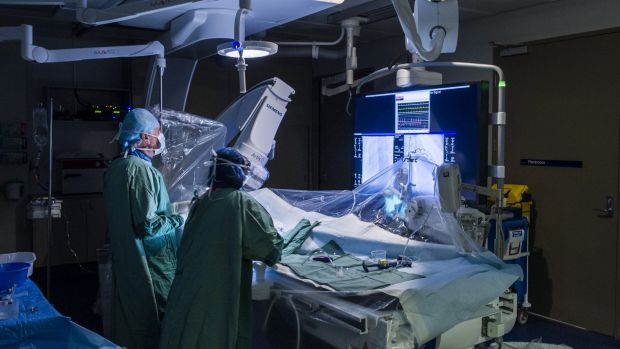
Surgeons work on a patient in Canberra Hospital’s new Cardiac Catheterisation Laboratory. Photo: Rohan Thomson
Cardiology patients at Canberra Hospital will be treated more quickly and exposed to less radiation using a new $1.27 million machine on display on Thursday.
The new technology also allows cardiologists to get more accurate images of the heart to provide more precise care.
“This cardiac lab is helping to save lives every day. Improving survival rates for people with angina and heart attacks is the key task here and this new investment in equipment is helping our doctors and nurses to perform that care even better, with survival rates that are better than the national average,” Health Minister Simon Corbell said.

Canberra Hospital’s new Cardiac Catheterisation Laboratory allows patients to be treated more quickly and exposed to less radiation. Photo: Rohan Thomson
Dr Ren Tan, director of cardiology at Canberra Hospital, said the hospital’s new Cardiac Catheterisation Laboratory was only the third in Australia.
“It will now allow us to treat more patients with angina and heat attacks to allow us to deliver efficient care and reduce the length of stay in hospital. It can get them to diagnostic and treatment procedures quickly,” he said.
“The main advantage of this machine is that it now allows us to be more precise in our procedures, because the X-ray tube and X-ray receptor are completely new.
“The radiation levels emitted by the machine are extremely low, so it improves safety for patients and staff.”
About 1900 diagnostic and coronary interventional procedures were performed at Canberra Hospital last year and about 530 cardiac rhythm devices were implanted, Dr Tan said.
The new $1.27 million machine has already been used in 293 cases since it was commissioned in October as a replacement for the old cardiac catherisation laboratory system.
Dr Tan said the prevalence of heart disease was increasing.
“We still have major issues with smoking rates, we obviously have a big increase in the number of patients having diabetes, obesity. All of those patients are really at risk of getting heart disease as they live longer,” he said.
“We’re also seeing that people are living longer, especially in the ACT, which has the highest life expectancy [in Australia], so as they get older, we’re seeing a higher prevalence of heart disease.”
Mr Corbell said heart disease and related conditions were a big problem in Canberra and nationally.
Risk factors for heart disease include being overweight or inactive, having high blood pressure or cholesterol levels, being diabetic, and depressed or a smoker, as well as having a family history.
Heart Foundation ACT chief executive Tony Stubbs said for people to maximise their heart health, they should be active every day, avoid smoking, eat healthily and maintain a healthy body weight.
People aged 45 and older are advised to get their blood pressure and cholesterol checked and discuss with their doctor how to manage it.
